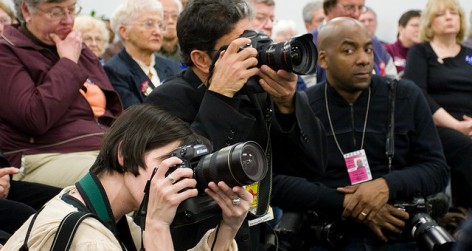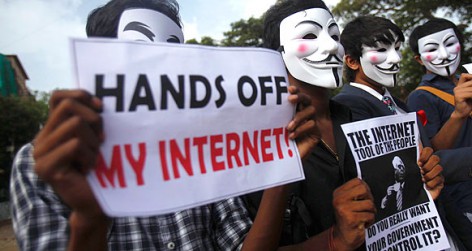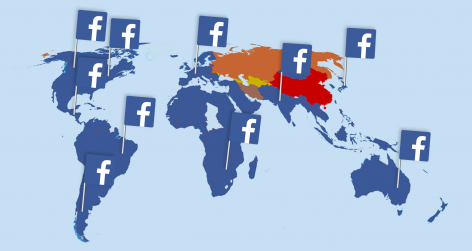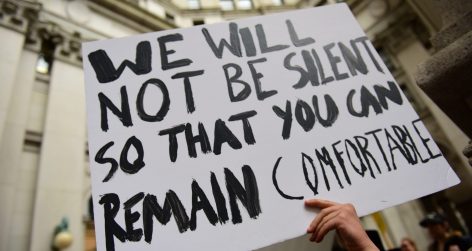پیٹر مولنار لکھتے ہیں کہ موبائل آلات کی بڑھتی ہوئی رفتار اور پھیلاؤ نے آن لائن ‘نفرت آمیز گفتگو و تقریر’ کا سیاق و سباق بدل دیا ہے.

اس بات کو زیادہ عرصہ نہیں گزرا جب انٹرنیٹ پر نسل پرست مواد یا دیگر اشتعال انگیر مواد کی وجہ سے کسی کو تشدد کو خطرہ ہے. لیکن موبائل آلات پر انٹرنیٹ کی تیزی سے ترقی نے اس کو بدل دیا ہے. نفرت و تعصب سے بھی لوگ اب نظریاتی ہدایات اور یہاں تک کے عملی ہدایات کے لئے ایسی ویب سائٹوں کا رخ کر سکتے ہیں جو مخصوص گروہوں کے خطرناک ‘دشمن’ قرار دیتی ہیں اور ان کے اوپر حملوں کو جائز ‘سیلف دفاع’ قرار دیتی ہیں.
میں نے ٢٠٠٨ میں بڈاپسٹ میں ایک ایل جی بی ٹی کیو پریڈ کے سیاق و سباق میں مندرجہ ذیل الفاظ لکھے تھے:
‘انٹرنیٹ پر تشدد کی طرف براہ راست اکسانا، چاہے وہ دور سے ہی کو نہ ہو (جیسے کے موبائل آلات کے ساتھ اکثر ہو گا) ‘نفرت آمیز گفتگو و تقریر’ کے ساتھ ملا کر ان معیارات پر پورا اترتا ہے جو کہ تشدد کی صاف اور براہ راست دھمکی کی تعریف ہیں. انٹرنیٹ پر تشدد کی طرف اکسانا، چاہے وہ کسی محسوس گروہ یا آدمی کی طرف ہی کیوں نہ ہو، ‘نفرت آمیز تقریر’ کے ایک براہ راست مظاہرے سے پھر بھی مختلف ہے.’
چار سال بعد انٹرنیٹ تک رسائی والے موبائل فون اب ایک بڑھتی ہوئی آبادی کے پاس ہیں. تشدد کی طرف اکسانا اب ضروری نہیں کے کہیں ‘دور دراز’ سے کیا جاۓ. یہ ایک فٹبال سٹیڈیم یا پب کے آسانی سے اشتعال انگیز ماحول میں بھی ہو سکتی ہے.
٢٠٠٨ میں بڈاپسٹ میں ایل جی بی ٹی کیو پریڈ کے موقعے پر اکسانے کے بارے میں میں نے یہ لکھا تھا:
‘اس اکسانے کے تشدد کو پھیلانے میں کلیدی کردار دیکھتے ہوئے ہمیں جدید ذرائع مواصلات (جیسے کے ریڈیو) کا روانڈا میں نسل کشی کے دوران استعمال یاد رکھنا چاہئے. نفرت پھیلانا کے علاوہ ریڈیو ٹیلی وزن دے مللے کوللینے نے ملوث افراد کو متاثرین کے بارے میں براہ راست اور قابل عمل معلومات فراہم کی.’
موبائل آلات کی ترقی نے ‘نفرت آمیز گفتگو و تقریر’ کا سیاق و سباق بدل دیا ہے. انٹرنیٹ پر ہدفی گروہوں کے خلاف اشتعال انگیز گفتگو (جو کے اکثر تعصب کی شکار اقلیتیں ہوتی ہیں جیسے کہ روما-ہنگیرین) ریڈیو کی طرح لوگوں کی ایک بڑھتی ہوئی تعداد تک پہنچ سکتی ہے کیوں کے یہ کمپیوت کی فکس جگہ سے محدود نہیں ہے.
مندرجہ ذیل باتیں انٹرنیٹ یا ریڈیو کے زریعے آزاد اظہار راۓ پر ایک وسیع پابندی کی دلیل نہیں ہے. یہ آزادی کی ٹکنالوجیاں ایک کھلی، ایمان درانہ اور بھرپور عوامی بحث کو ممکن بناتے ہیں. جیسے کے میں نے پہلے بھی کہا ہے، ‘انٹرنیٹ کے دور میں تقریر و گفتگو پر ان کے مواد کی بنیاد پر پابندی لگانا ایک ساۓ پر چھلانگ لگانے کے مترادف ہے. قانونی پابندی صرف ان کیسوں میں استعمال ہونی چاہئے جس کی وجہ سے کوئی براہ راست خطرہ لاحق ہو. …ادب اور علم ایک وسیع تر سیاق و سباق میں ‘نفرت آمیز گفتگو و تقریر’ کے خلاف سب سے مؤثر ہتھیار ہیں؛ یہ عام بیانیہ کو ایک مضبوط طور پر ٹھیک کر سکتے ہیں کیوں کے ان کا ہدف تعصب اور نفرت کی جڑیں ہوتی ہے: جیسے کے لاعلمی، غلط فہمی اور غلط عقائد.’
یہ دلیل دے کر کہ انٹرنیٹ کے زریعے ‘نفرت امیر گفتگو و خیالات’ پھیلانا آسان ہو جاتا ہے (کیوں کے اس سے ذرائع مواصلات حد درجہ بہتر ہو گاۓ ہیں) بار بار یہ کہنا کہ مخصوص ‘نفرت آمیز تقریر و مواد’ پر پابندی ہونی چاہئے، میں ایک متبادل لائحہٴ عمل پیش کرنا چاہتا ہوں.
کیوں نہ ہم اس تکنیکی ماحول کو بدلنے پر توجہ دیں جس میں نسل پرست تقریر و مواد اور انٹرنیٹ پر اشتعال انگیز باتیں کسی کو براہ راست خطرے میں ڈالتی ہیں. ہمیں ان حالات و واقعات پر توجہ دینی چاہئے جن میں موبائل آلات کے زریعے ہم آن لائن نفرت اور اکسانے والے مواد کو ان جگہوں سے کنیکٹ کر سکیں جدھر عملی طور پر تشدد ہونے کا امکان ہو. ایسے ماحول میں نفرت کی طرف آن لائن اکسانا براہ راست خطرے کی وجہ بن سکتی ہے اور اس طرح آن لائن اشتعال انگیزی اور عملی خطرے کے درمیان ایک صاف لنک ہو گا. موبائل آلات نے براہ راست خطرہ پیدا کرنے والی اشتعال تقریر و گفتگو اور اخلاقی طور پر گھٹیا لیکن آئین کی طرف سے محفوظ تقریر و گفتگو کے درمیان ایک صاف سطر کھینچ دی ہے.
پیٹر مولنار کتاب ‘نفرت آمیز گفتگو و تقریر کا مواد اور سیاق و سباق: جوابات اور قانون سازی پر از سر نو غور’ کے ایک چیپٹر کے مصنف اور شریک ایڈیٹر ہیں.























reply report Report comment
Response to ‘When an iPhone can be dangerous’ by Peter Molnar
We are two students who are currently looking into the language of Taboo and Hate Speech. When we stumbled across your article, When an iPhone can be dangerous we could not resist but to write a response.
The arguments in the text primarily focuses on the negative aspects of technology, while the positive factors are neglected. What about the use of the iPhone that is actually beneficial to us? To call the emergency number (112/911) when in trouble, instead of having to scream your lungs off; to donate money through simply one text message, supporting various charity organizations and being able to make the world a better and healthier place?
Technology is the effect, not the cause.
People even argue that gadgets such as the iPhone is making us more organized.
A calendar at our fingertips makes it easy to slip in appointments, reschedule or cancel and is able to notify you when you have an event scheduled. This makes it impossible for a lazy someone to ‘forget’ to do the dishes, vacuum or put dirty clothes in the damper. The iPhone simply answerers our request for bigger, faster and stronger.
Your statement about the communication in the Rwandan Genocide, is in fact not merely the radio that was the primary issue of the destructive event but rather the past history that was the main cause of it. The technology indeed supported the genocide in the way that communicating propaganda and messages became simpler but the radio was only a small factor. The colonization of the Belgians and the following death of the Rwandan president Juvenal Habyarimana, agitated its citizens and created a barrier between them. To be branded by one’s looks as an ‘either or’ object (Tutsi or Hutu) intensified the anger as time went on, especially since one side, the Tutsi, was seen as the ‘better’ by the Belgians.
Technology can evoke hatred, but it has also brought out an entire revolution, the Arab Spring. Social media, such as Twitter and Facebook, is the cause for this imminent and rapid change of events. Due to its simplicity and availability it is easy to bring thoughts and ideas to millions who might otherwise not be connected. Wael Ghonim chief and symbol of the revolution in Egypt states “This revolution started online. … We would post a video on Facebook that would be shared by 60,000 people on their walls within a few hours. I’ve always said that if you want to liberate a society just give them the Internet.”
You also state “In such environments, incitement to hatred on the internet can create imminent danger with a direct causal connection between online incitement and clear and present danger”. What is imminent danger, and how would one measure it in this context? The sentence seems rather vague and hyperbolic. Also throughout the article, you move quickly from one strong example to another, but barely provide any counter examples for support; it leaves the reader confused and with examples that are simply floating around.
Technology indeed has the capability to bring a person into danger, as well as being able to do the exact opposite. However, one ought not to forget that the use of the hand-held brain (the iPhone) has made our lives change into a whole other dimension.
From the students in the American School of the Hague
reply report Report comment
The Internet has become one of the largest sources of communication between people globally. Aside from the increasing communication, technology allows people to watch and receive global news at a faster speed and allows people to create websites and express their opinion freely on specific issues. Blogs and opinion articles have become increasingly popular and are easily accessible through technological devices such as smartphones and laptops. This exact platform can be used to excite hatred targeting a community, group of people or an issue.
Take, for example, a harmless Tumblr blog that belongs to a teenage fan of the popular band One Direction. She publishes posts expressing her hatred towards the girlfriend of one of the members of the band. The fan claims that the girlfriend is fake and a scheme to hide the band member’s homosexuality. The blog has over 100,000 followers, which lead to a cult of fans freely posting confessions and opinions about the relationship. The blog has earned a lot of fame, and with more confidence than when she started, the owner of the blog now bids her followers to send twitter threats to the girlfriend. This is a small example, but has a huge impact on all the parties involved and carries a powerful message of how people use technology to spread opinions that lead to “hate speech,” or speech that specifically targets a person or group on basis of race, religion and sexual orientation. Such sites should be taken down, because the hate is directed towards one person or group, and can hurt someone badly. However, one could argue that everyone has a right to express ones opinion, but using a public platform to blatantly direct hate towards someone is wrong.
Another popular characteristic that triggers hate speech is anonymity. As technology has developed, people now have the advantage of anonymously publishing posts. This gives them a sense of security to freely communicate and allow people to be involved with things like scandals for example. Anonymity has led to many new issues, one of the biggest being cyberbullying. Cyberbullying has become a phenomenon around the world and is becoming increasingly popular. Recently, a new site has emerged called Ask.fm, which was intentionally created to ask a specific person innocent questions anonymously. However, it quickly escalated to a vehicle that allows you to bash that specific person with hurtful statements rather than questions without that person knowing whom it is. An article in CNN claims that teenagers use apps such as Ask.Fm to change their identity and make cruel statements to other teens, and it has become a big source of cyberbullying. A recent case of a suicide by a teen due to hate from Ask.fm has sparked discussion about whether sites like these should be abolished. Sites, such as Ask.fm do hurt people, and people should not be allowed blatantly hate on someone using such means.
Despite the fact that technology has greatly benefitted the lives of many, and given the ability to freely post on the Internet, gives us a sense of freedom, however people have misused this facility. Instead the Internet has become one of the biggest and most accessible sources for hate crimes against communities or groups of people.
Ria and Marijne, ASH Grade 11, English IB SL Yr-1
reply report Report comment
Unfortunately the greatest danger inherent to ubiquitous technology is not found in the user or their actions.
It is the tool itself and the perceptions of the abilities of that tool that are the real dangers.
While surfing the web on an iPhone you would be forgiven for believing that you are granted unfettered access to all areas. In reality what you are permitted to view is a carefully filtered selection of results relative to your location, political situation or any other relevant factor.
The naive belief that a Google search result is based solely on the search criteria is again understandable as our perception of the tool would imply this logic. However many would be disturbed to discover that their queries were actually producing results relative to the user’s profile and history instead of relevant search criteria.
This enables organisations such as Google and Apple to effectively control free expression of thought by diverting users to more profitable or preferable services such as YouTube or iTunes, all without the knowledge or consent of their users.
PROOF – search the same Google query from both yours and a friends computer whilst logged in and logged out, observe the differences.